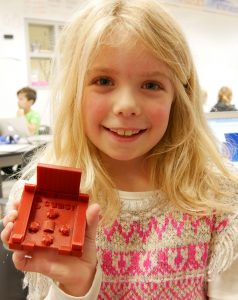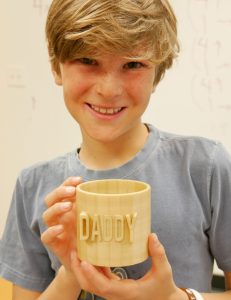Do you remember an era when students were disciplined for classroom misdeeds by staying inside during recess?
At CA’s Lower School iLab, the opposite is true—students beg teacher Bill Witt for the chance to miss recess and instead spend the time in the classroom, inventing and creating with 3D printers.

Twice during every 6-day rotation, Witt hangs a sign on the iLab door signaling that today is a “3D day,” and a flood of students from Grades 1 through 5 descend on the iLab during their recess times. Third grader Mckenna Farrell is already a veteran creator of items on the 3D printer with a castle, rocket, and a detailed kingdom to her credit. Her most recent creation is a model of the Chicago Cubs home, Wrigley Field, which she made for her father. “He’s a huge Cubs fan,” Mckenna explains. “When they won the World Series, he was psyched!”
Mckenna’s skills serve as an inspiration for her fellow third graders. “She’s about the best 3D printer I know,” Jackson Lontz observes. “Mckenna does huge designs. I don’t know how she gets so much detail in them!”
‘They just keep coming back’
Witt starts encouraging students to design and create using 3D modeling software in the first grade. Students take a note home explaining how parents can help set up a free online account at www.tinkercad.com. With log-in information from parents, Witt helps students get into their accounts and learn the basics of the 3D modeling software.
During their very first lesson, they create a tag that can be attached to a backpack. (Mckenna created a heart with the raised letter “M” in the middle.) That first lesson helps students see how the software will let them put in holes, add shapes, and create designs that can be produced by the two always-busy 3D printers in the iLab.

“After that first lesson, they have the basics, and they get immediate gratification when they see the item they designed produced by the printer,” Witt says. “Then they just keep coming back.”
As students get older, their designs become more complicated. Tierney Williams, a fifth grader who started 3D printing in the iLab 3 years ago, recently designed a horse farm, complete with barn, fences, and horse jumps.
Fourth grader Philip Foreman just finished a cup for his father with “Daddy” printed on the outside. “You can be proud of something when you have finished it,” he says. But you can also learn from your misjudgments. The cup has a small hole rendering it problematic as a coffee cup, so it will be transformed into a pencil holder—and Philip will make a second attempt at creating a leakproof cup.
‘The basis for design thinking’
For the students, 3D creation in the iLab is more fun than recess, and Mckenna points out an added advantage—on wintry days it’s a great place to “avoid the cold!” But it’s also an excellent opportunity for very young students to learn CAD (computer-aided design), which could be the basis for their professional careers as architects, engineers, bioengineers, drafters, artists, and any profession which demands precision drawings or technical illustrations.

“They also learn foundational math,” Witt says. “They have to do measurements and identify geometric shapes. It’s all the basis for ‘design thinking,’ where students experiment to generate innovative solutions.”
That’s how, in Bill Witt’s iLab, recess is redefined, as students fly into the room, flop onto the floor, open their Tinkercad accounts and get to work. Second grader Chagall Clinemills is making a village for her twin sister. Third grader Abby Hollis stares at the printer, mesmerized as it produces her design of a horse. Mr. Witt finds he doesn’t have to do much instruction—he just coaches students as they direct themselves on to the next project. “That’s what we are about at CA,” he says. “We can have 3D printers that allow kids to create, invent, and solve problems.”
